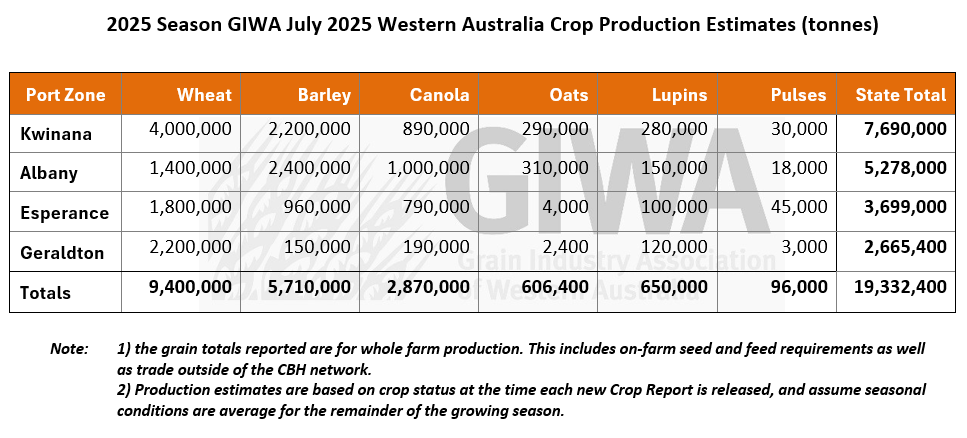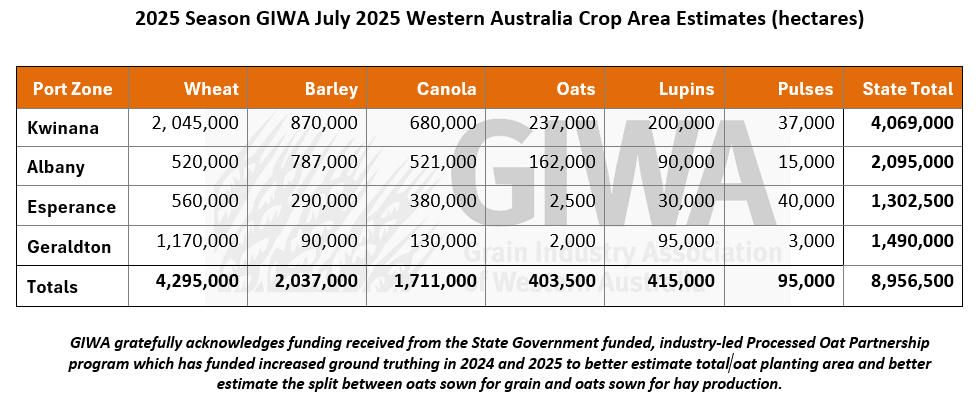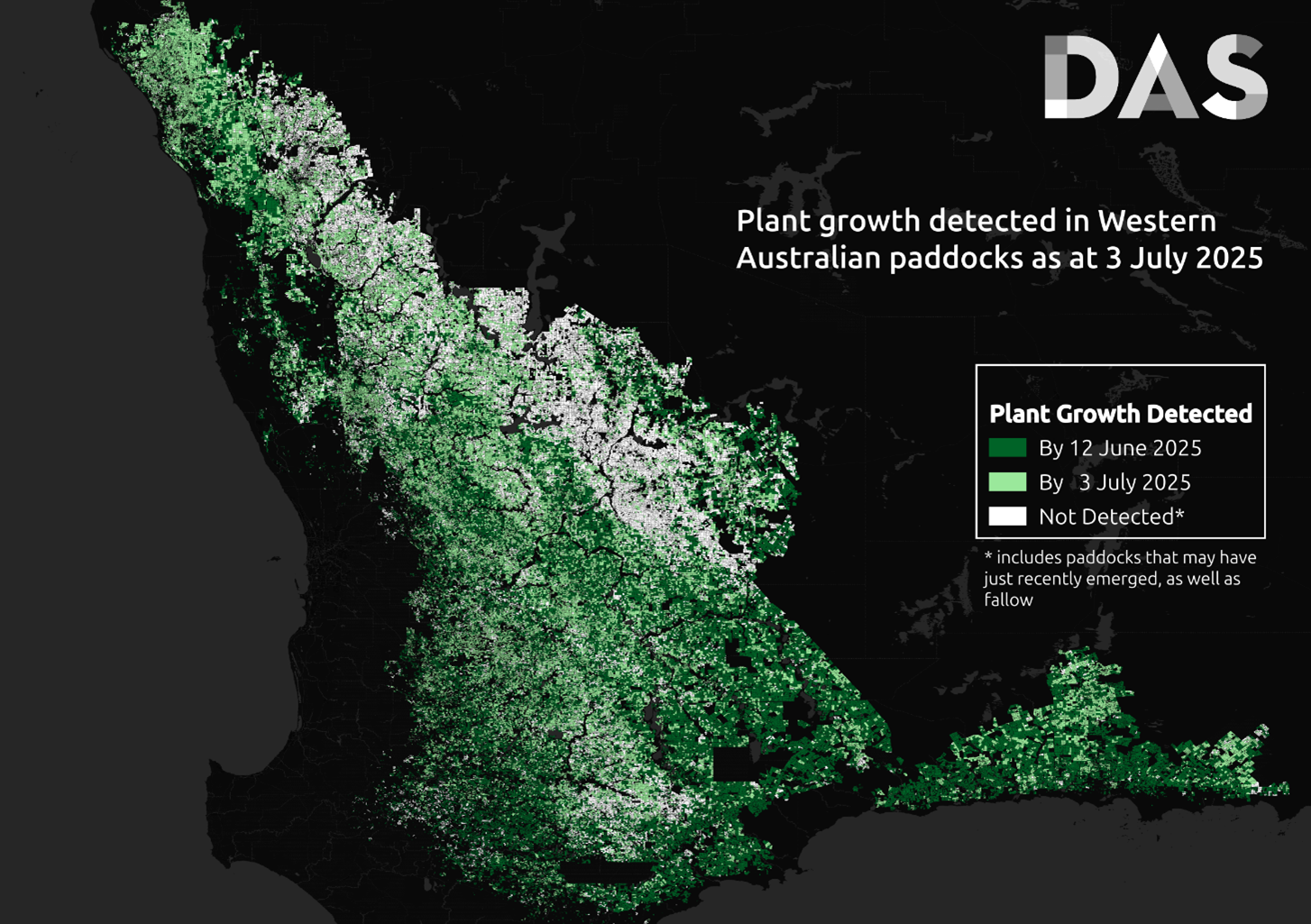Crop growth stifled by lack of winter rain
The widespread rainfall over the last week has completely transformed the majority of the grain belt from a dry dusty wreck, particularly in the central regions, to a scene of fresh optimism. The season was slipping away from many but the rainfall has turned around the prospects for reasonable crop yield potentials. However, there are still pockets of country across the grain belt where the rain has been too little, too late, and these areas will struggle no matter what happens from now on.
The staggered timing of crop emergence in the Western Australian grain belt both across and within regions, has made predictions of final outcomes difficult at this point in the grain growing season.
Areas of the state that emerged early are in very good shape and are packing on biomass that will set them up for above average grain yields provided they continue to get top-up rainfall over the next few months. Crops in these areas are as good as the record tonnage years of 2021 and 2022, although it is still a long way to go until harvest. To hit these very high tonnages, they will need to continue to receive regular rain and mild finishing conditions.
The areas that emerged later are behind in growth stage and were struggling until the rain received over the last few days. Around 4 million hectares had emerged by the first of June mostly in the Esperance, south coast, west Albany port zone and corridors north to the central regions. A further 4.6 million hectares had emerged by mid-June. The remaining 300,000 hectares of planted area has only recently come through the ground. The later emerged crops, particularly those in the low rainfall regions, are going to need a very good run from now on to achieve average grain yields at harvest time.
With the current soil available moisture low in all grain growing regions, the rain from now on is going to need to be above average to achieve a state total of 20 million tonnes of total grain.
Crops have had a dream run for disease up until now due to the dry conditions. The slight shift from wheat to barley area seems to be paying off as the barley is very clean and the earlier sown barley crops will blitz wheat yields if the season tightens up from now on. In saying that, most wheat crops are in good shape except for the later emerged areas in the low rainfall areas of the Kwinana North East and Kwinana South zones. Many of these wheat crops have below average grain yield potential at this stage of the season.
Canola crops are mixed across the regions with very high yield potential in the higher rainfall regions, right through the spectrum to below breakeven yield potential in the later emerged lower rainfall regions where plant density is low and variable across paddocks. Lupin crops in the inland areas have been slow to grow due to the cold conditions, although closer to the west and south coastal areas where they emerged earlier and have the warmer coastal influence, they are more advanced. Oat area intended for grain increased again this year in the dedicated grain growing regions, with the majority of these areas coinciding with the later break to the season and less rain since emergence.
The pulse crops in the Esperance region have benefited from the early start, but in the remainder of the state where a slight increase in pulse plantings has been seen, crops have emerged late and will need a good spring to hit reasonable yields.


Seasonal Outlook
Ian Foster, Department of Primary Industries and Regional Development

Seasonal Climate July 2025
Rainfall
June rain has been below normal for much of the central, eastern and parts of the southern cropping areas. While soil water storage has increased closer to the coast, it remains lower than normal for much of the region (see Figure 1).
Follow-up rain is expected in the coming week, although it is likely to be lighter away from the coast. This may limit opportunities to consistently build soil water reserves.
Forecast
Climate conditions in the Pacific Ocean are expected to remain neutral. Waters over the eastern Indian Ocean are warmer than normal and are predicted to continue warming through winter.
Climate models continue to predict the development of a negative Indian Ocean Dipole in spring, with predictive skill improving for forecasts made in winter.
The Bureau of Meteorology’s monthly rainfall outlook for August indicates near-normal rainfall chances. The seasonal outlook for August to October 2025 is for normal or above normal rain being more likely (see Figure 2).

Figure 1: Estimated root-zone soil water storage rankings 7 July 2025. Source: Bureau of Meteorology (2025)

Figure 2: Rainfall outlook for August to October 2025. Source: Bureau of Meteorology (2025)
Temperature
Seasonal temperatures since April have been much above normal. Seasonal forecasts indicate warmer conditions will persist through winter into spring.
Additional information is available from:
BoM: Rainfall totals for growing season 2025 to date
BoM: Rainfall outlook for the next week
BoM: Seasonal Rainfall Outlook
Geraldton Zone
There has been a major turnaround across the region in recent weeks following the late break in June. The even crop establishment, combined with accelerated growth due to warm weather and widespread rainfall over the past two weeks, has pushed crops along nicely. Normalised Difference Vegetation Index (NDVI) imagery confirms the region is well ahead in crop development compared to the same time last year. Grain yield potential is now good, particularly if August and September rains materialise.
Canola has surged ahead with some varieties beginning to flower, while wheat and barley are also pushing through their growth stages. Nutrient uptake has been excellent due to the absence of leaching rains, and first and second round nitrogen applications have been applied in the higher rainfall areas to push potential yields up. The increasing adoption of coated urea is enabling better nitrogen application timing and growers are more confident to apply prior to predicted rainfall events. These new products are having a significant positive impact on grain yields from improved nitrogen use efficiency, especially in northern areas with short, fast-growing seasons where timing is critical.
The warm and consistent rainfall patterns have allowed the non-wetting soils to establish well this year, particularly in the north. Although the southern areas with less consistent rainfall are still experiencing some non-wetting and chemical damage issues, particularly in gritty granite soils.
The wheat-dominant cropping program is well suited to the current season, with short-season varieties and reduced frost risk helping crops make the most of late May–early June emergence. Overall, rapid growth and minimal setbacks have positioned the region well for the remainder of the season.
Kwinana Zone
Kwinana North Midlands
Early July rainfall across the region of between 30–50 mm in total in most areas has significantly improved crop conditions, with paddocks visibly becoming greener seemingly overnight.
Crop development is staggered due to varied break timings, soil types, and persistent non-wetting soil issues, particularly in high-production belts where there is less soil amelioration. Crop growth has been slower due to colder conditions and NDVI imagery shows it is tracking slightly behind last year, although soil moisture levels are now ahead of 2024. The current crop conditions could support an average to above-average season provided there is good August–September rainfall.
Most growers applied top-up nitrogen before the rain, and this will help push crop yield potential at the end of the season. Crops are very clean for disease due to the dry conditions, although bugs such as Red Legged Earth Mite (RLEM) and Lucerne Flea have been prolific, as they have over the majority of the grain belt this season.
Kwinana South
Crop variability is stark and clearly visible on the ground and in recent satellite imagery. A distinct strip of struggling crops stretches from the southeast of the Southern Kwinana zone right through to the Northeast Kwinana zone.
Crops in the drier areas of the zone are going to be vulnerable to spring heat and drought, and while the recent rain event has provided some relief, many have already suffered unrecoverable stress during the warm, dry spell in late June. Soil moisture reserves remain low across all areas, and yield potential is heavily reliant on July to August rainfall. Crops have been “living on fumes” and need a decent drink in all areas.
Outside the “harsh” zone, conditions improve rapidly, and slightly above-average yield potential is still possible if August brings enough rain, particularly in the western areas where there is still time for crops to pick up and hit average grain yields.
It’s amazing how a little rain can make a huge difference and in the western regions of the zone, crops that were struggling a week ago are now powering along across areas around Wongan Hills and the Avon Valley. Even though crops were significantly later to emerge in the Wongan area compared to the Avon Valley, the warmer soils have seen the crops grow very quickly. The Avon Valley has missed out on the larger rainfall events, but it isn’t without moisture and crops are slowly ticking along. Many of the crops that were very patchy after the first rains in June are now starting to fill out. Unfortunately for some to the east of Wongan, canola is still patchy at best. Those who have re-seeded now have crop coming through to fill the gaps, while others will manage paddocks the best they can for weeds.
Bugs have been a nuisance, and cereals have needed spraying for RLEM and Lucerne Flea which is unusual. Leaf disease pressure has been low, although preventative fungicides have been going out or will be going out in anticipation of increasing infection levels now there has been widespread rain in the western portions of the zone.
Kwinana North East
It has been a challenging season across the region, with most crops delayed and moisture availability limited. While some areas that received early rainfall—such as west of Dalwallinu and east of Beacon— established well and are performing reasonably, much of the zone is dry, with cereal crops generally only at the four-leaf stage and surviving “hand-to-mouth” on moisture.
Nitrogen application is proving difficult to justify under current conditions. The Shire of Koorda is currently sitting on decile 2–3 for yield potential, and most growers are managing expectations around an average season at best. The region is heavily reliant on late July and August rain.
The widespread lack of consistent rainfall continues to limit growth. In some of the worst areas, achieving 1.0–1.5 t/ha in wheat would now be considered a good outcome.
Satellite imagery highlights a narrow strip with improved performance, although much of the broader corridor remains stressed, with some zones only receiving around 10 mm of rain in the past week, with areas around Goodlands, Bencubbin and Mukinbudin getting insufficient to change crop prospects. Large areas from Bonnie Rock and further south encompassing the whole far eastern regions of the zone down past Moorine Rock, that did get an early start and look good on NDVI maps, are now suffering from limited soil moisture reserves and will struggle to sustain growth without good follow up rains. The majority of the eastern portion of the zone is experiencing similar deceptive conditions as crops may appear visually sound, but lack underlying moisture to sustain growth.
The area of fallow is up in the zone from 2024 and this may still increase if the season does not improve and crop paddocks are chemically fallowed.
Albany Zone
Albany West
Crop conditions across this region are mixed, with crop development highly dependent on rainfall variability. The eastern areas around Nyabing and Ongerup are struggling due to low subsoil moisture, despite good germination, and NDVI imagery suggests limited growth. However, recent rainfall of around 20 mm from two systems has helped some crops improve, and their yield potential now sits around average to slightly below average.
The western regions, particularly west of the Albany Highway and around Broomehill, are faring much better, with crops—especially canola—looking excellent with some at 10 per cent flowering. Cooler temperatures are finally being felt, though growth has still been strong. Crop performance will hinge heavily on rainfall through August and September, although most growers in the region are cautiously optimistic considering how the improvements in crop genetics are driving water-use efficiency to higher levels than just a few years ago.
Further south, the Franklin area has received significant rainfall (50–75 mm recently, up to 300 mm YTD), with waterlogging becoming a concern if more rain arrives soon.
There is a stark contrast between regions west from Nyabing to Arthur River where there is a dramatic improvement in crop conditions, with some areas appearing almost ideal. The shift is geographically sharp, with a visible line 5 km west of Broomehill marking better rainfall and crop performance to the west.
Crop potential in the east sits around average to slightly below average and will be dependent on August to September rainfall. Western areas (west of Albany Highway and Broomehill) are in very good shape, with “crops as good as they’ve ever been.”
Albany South
The south coastal regions of the Albany port zone have received good follow up rain, unlike those areas north of the ranges, and are now on track for a very good year. In the western parts the recent rain has topped up the soil moisture profile to a point where it is on the verge of waterlogging, although the advanced stage of crop development means they should be able to handle the conditions without suffering too much yield loss.
The early start to the season in this region and resulting extra length of growing period, should result in all crops hitting very high grain yields.
Albany East (Lakes Region)
The region is mostly in good shape now following the recent rains. The northeastern and southwestern margins of the region are still behind in growth stage and patchy across the different soil types, and these areas will struggle now to hit average paddock grain yields even with an average finish to the season.
The earlier crops have bulked up and taken off with the recent rain and look the goods at this stage of the season, although subsoil moisture reserves are low and unless these get topped up in July and August, the current crop yield potential will not be realised.
There was a swing back into barley in the region this year and these early planted crops are very clean and will have the jump on wheat. They should maintain most of their yield potential if the season does tighten up in the spring.
Esperance Zone
Following the recent rains, crop conditions are now good right across the zone with grain yield potential increasing to a point where the potential is as high as the record grain production years of 2021 and 2022.
The heavy soils that were sown late are now catching up in growth stage and the eastern areas that did not receive the early rains have improved from the few rainfall events in June and mild warm growing conditions. The whole zone is now more even than it has been for a few years and this evenness across a lot of hectares has the potential to produce some very good crops if the nice growing conditions continue through the spring.
The coastal regions have had a few repeat rainfall events of more than 50 mm and whilst waterlogging has not yet set in, this will be a risk if the crop growth cannot keep up with the rain.
Crop growth stages are quite varied reflecting the slightly staggered start to the growing season. Disease pressure is low in all crops including pulses. Canola ranges from first flower to over 50 per cent flowering. Cereals are mostly at first node or beyond; the early barley is nearing flag emergence, with northern Beaumont and northwest Salmon Gums slightly later due to delayed germination.

Examples of shires where the emergence at the end of June was well behind 2024, Merredin 35 per cent, Koorda 58 per cent and Gnowangerup 72 per cent of paddocks emerged compared to this time last year. Source: Digital Agriculture Services (DAS).